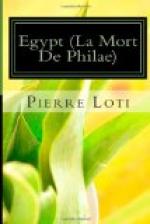In any case Christianity was so firmly implanted in this Egypt that centuries of persecution did not succeed in destroying it. As one goes up the Nile, many little human settlements are to be seen, little groups of houses of dried mud, where the whitened dome of the modest house of prayer is surmounted by a cross and not a crescent. They are the villages of those Copts, those Egyptians, who have preserved the Christian faith from father to son since the nebulous times of the first martyrs.
*****
The simple Church of St. Sergius is a relic hidden away and almost buried in the midst of a labyrinth of ruins. Without a guide it is almost impossible to find your way thither. The quarter in which it is situated is enclosed within the walls of what was once a Roman fortress, and this fortress in its turn is surrounded by the tranquil ruins of “Old Cairo”—which is to the Cairo of the Mamelukes and the Khedives, in a small degree, what Versailles is to Paris.
On this Easter morning, having set out from the Cairo of to-day to be present at this mass, we have first to traverse a suburb in course of transformation, upon whose ancient soil will shortly appear numbers of these modern horrors, in mud and metal—factories or large hotels—which multiply in this poor land with a stupefying rapidity. Then comes a mile or so of uncultivated ground, mixed with stretches of sand, and already a little desertlike. And then the walls of Old Cairo; after which begins the peace of the deserted houses, of little gardens and orchards among the ruins. The wind and the dust beset us the whole way, the almost eternal wind and the eternal dust of this land, by which, since the beginning of the ages, so many human eyes have been burnt beyond recovery. They keep us now in blinding whirlwinds, which swarm with flies. The “season” indeed is already over, and the foreign invaders have fled until next autumn. Egypt is now more Egyptian, beneath a more burning sky. The sun of this Easter Sunday is as hot as ours of July, and the ground seems as if it would perish of drought. But it is always thus in the springtime of this rainless country; the trees, which have kept their leaves throughout the winter, shed them in April as ours do in November. There is no shade anywhere and everything suffers. Everything grows yellow on the yellow sands. But there is no cause for uneasiness: the inundation is at hand, which has never failed since the commencement of our geological period. In another few weeks the prodigious river will spread along its banks, just as in the times of the God Amen, a precocious and impetuous life. And meanwhile the orange-trees, the jasmine and the honeysuckle, which men have taken care to water with water from the Nile, are full of riotous bloom. As we pass the gardens of Old Cairo, which alternate with the tumbling houses, this continual cloud of white dust that envelops us comes suddenly laden with their sweet fragrance; so that, despite the drought and the bareness of the trees, the scents of a sudden and feverish springtime are already in the air.




